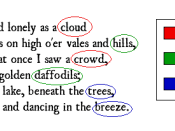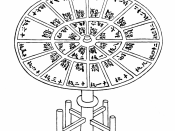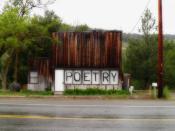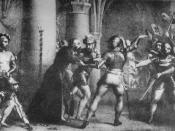This poem dramatizes the conflict between liberty and tyranny, specifically in instances where tyrannical forces attempt to squelch liberty by imprisoning those who champion her virtues. The speaker presents a paradox in the beginning of the poem, ÃÂEternal Spirit of the chainless mind!/Brightest in dungeons, Liberty, thou art,--For there thy habitation is the heart,--ÃÂ (1,2,3). The speaker personifies liberty and explains the paradox as the poem continues. Liberty is described as a living woman whose ÃÂsonsÃÂ (5) are ÃÂconsigned, to...dayless gloomÃÂ (5/6). In this gloom however, ÃÂlove of thee alone can bindÃÂ (4). The speaker creates a long metaphor in which to win, tyranny must make men turn their hearts against their mother.
Sonnet on Chillon is an Italian Sonnet. This form is important because conflict is settled at the end of the octet. After setting up the conflict and paradox, and presenting the metaphor of liberty as a beloved mother who must be betrayed by her children in order for tyranny to triumph, the speaker ends the octet saying ÃÂTheir country conquers with their martyrdom, And freedom's fame finds wings on every wind.ÃÂ
(7/8). Tyranny, by locking up liberty's sons in ÃÂdamp vaultsÃÂ (6) succeeds only in creating martyrs whose example inspires the people, leading to their downfall.
The rhyme scheme in the octet follows the pattern of a typical Italian Sonnet, A, B, B, A, B, C, C, B. The first quatrain uses auditory rhymes ÃÂMind!ÃÂ (1) and ÃÂbindÃÂ (4), ÃÂartÃÂ (2) and ÃÂheartÃÂ (3). The second quatrain though, is all site rhymes, ÃÂconsignedÃÂ (5) and ÃÂwindÃÂ (8), ÃÂgloomÃÂ (6) and ÃÂmartyrdomÃÂ (7). This auditory dissonance forces the reader to slow down by breaking the rhythm of of the poem, making the reader think more about the speaker's message and acknowledge the seriousness of the speakers intent.
After placing the reader in a position of finality, with the conflict already resolved and the speakers views made clear, the use of the Italian Form allows the speaker to continue. The sextet begins, ÃÂChillon!ÃÂ (9). The exclamation grabs the readers attention, telling him that the speaker has more to say; ÃÂ...thy prison is a holy placeÃÂ (9). After using the octet to illustrate what could be a hypothetical situation of tyrannical oppression, the speaker declares boldly as the poem goes on that the situation is real, describing the prison as a ÃÂholy placeÃÂ (9) whose ÃÂaltarÃÂ (10) was consecrated by the ÃÂstepsÃÂ (11) that ÃÂleft a trace...as if thy cold pavement were a sod,ÃÂ (11/12). The reader now knows that the prison is real, and that the martyr is real and has been imprisoned so long as to wear through stone by walking upon it's surface. The speaker then names his martyr; ÃÂ...Bonnivard!ÃÂ (13).
The sextet follows as simple rhyme scheme, D, E, D, E, D, E with all rhymes being auditory ÃÂplaceÃÂ (9) ÃÂtraceÃÂ (11) ÃÂeffaceÃÂ (13) and ÃÂtrodÃÂ (10) ÃÂsodÃÂ (12) ÃÂGodÃÂ (14). The straightforward rhyme scheme, combined with the exclamation points at the beginning of lines 9, 13 and 14 give the sextet a quick rising rhythm that creates excitement, enticing the reader to the speakers cause. The speaker ends with ÃÂFor they appeal! From tyranny to God.ÃÂ (14), halting the rising rhythm at a high place and purposely ending both the poem and his appeal to the reader with an appeal to God. The speaker leaves the reader swayed to his cause, if not by the rising fervent pace of the sextet, then by appeal to a higher metaphysical authority.
Works CitedByron, Lord. "Sonnett on Chillon". Byzant Scriptorium. 18 September 2009





